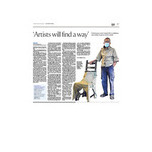2023-07-16 23:28
Tang Da Wu thinks of himself as a work of art. “I am the canvas,” he says.
This is not grandiloquence or affectation. The 79-year-old artist means it plainly.
For his latest exhibition, Art School SG: Tang Da Wu – Artist Sees Colours Differently, he is wearing a shirt of his own design and make.
“Here, the paint is the cloth,” Tang says. Every 10 days, the artist – who also sews – will transform the shirt into a pair of trousers which he will then wear.
One expects the work of one of Singapore’s foremost performance artists to be more than a little post-modern. But he takes his craft so seriously that he probably lives every moment as art.
Take, for instance, his description of the genesis of a new work comprising a chair and a garment that was previously a pair of trousers purchased from a shop that sells labourers’ clothes. “This is the chair I sit on to work. And the trousers I wear when I work. They are so close together every day.”
Not wanting to separate the chair from the trousers, he modified the trousers to fit the chair. “The chair has four legs, so I made two more legs for him. But it’s not easy. I have to make decisions every minute.”
He laboured over the semantics as well. “Is this a chair and a pair of trousers or a chair and two pairs of trousers? I don’t know.”
If this sounds bizarre, it may be because one of the artists Tang admires most is Dadaist Marcel Duchamp (1887 to 1968), who once famously declared a urinal a work of art.
Indeed, the exhibition can be considered a tribute to the great artists and thinkers Tang refers to as “teachers”, even though he has never met most of them.
They include Josef Albers (1888 to 1976), an exponent of the Bauhaus school – which aimed to unite the arts in one place and under one ideology – and Lim Hak Tai (1893 to 1963), founder of the Nanyang Academy of Fine Arts.
The ideas of Situationist International, which was formed by artists and intellectuals in the late 1950s and led by French writer, theorist and film-maker Guy Debord (1931 to 1994), also resonate with Tang. The movement sought to disrupt and reimagine the systems which govern everyday life.
For this exhibition, Tang created two provocative drawings titled Red Hand and Blue Hand, depicting hands holding a small revolver.
He says the work was inspired by the Situationists, who had in turn influenced the student uprising in Paris in the late 1960s. He had been studying in the United Kingdom at the time and travelled to the city to witness the civil unrest.
Tang moved to England in 1969 and studied at the Birmingham Polytechnic and Saint Martin’s School of Art until 1975.
He later also studied at Goldsmith’s College, University of London, where he received his Master’s of Fine Art in 1985.
After returning to Singapore, he started an artists’ colony in Sembawang called The Artists Village (TAV) in 1988.
For a while, it was home to other prominent Singapore artists, such as Chng Seok Tin, Jailani Kuning, Vincent Leow and Tang Mun Kit.
Following an infamous incident in which artist Josef Ng snipped off his pubic hair at an event in 1994, the National Arts Council started a no-funding rule on performance art, which affected the art world here. The rule was lifted only in 2003.
TAV still exists, but has never held quite the same sway. Of that post-1994 period, Tang says only that “it was very depressing”.
While there was no official ban on performance art, artists had to find their own way. In 1995, as a sort of art intervention-cum-performance, Tang eluded handlers at an art event to present a letter to then president Ong Teng Cheong, who was in attendance. The letter read: “I am an artist. I am important.”
Before being ushered away, Tang remembers the president smiling as he received it.
To subvert bureaucracy, he has even organised guerilla-style exhibitions. “I did my one-person solo show at the Singapore Art Museum (in 2010) and organised it myself.”
Without anyone’s permission, he installed his works in public lock- ers at the museum, paying the $1 required for each locker. He even made a catalogue for the show and invited guests, including then museum director Tan Boon Hui, who officiated the opening ceremony. When guests asked where the art was, Tang gave them each a key to a locker. The works were then retrieved and viewed in the
public courtyard.
“That is now a part of history. I had my one-man show in SAM. The only one I had at SAM. Artists will always find a way.”
Performance artists need an audience, so Tang has always taught part-time at art institutions like Nanyang Academy of Fine Arts and Lasalle College of the Arts.
“I started school workshops and the students became my audience,” he says.
He is currently teaching part-time at the National Institute of Education, Nanyang Technological University.
Tang says he likes “playfulness, teasing and questioning” and that the art for his latest exhibition is about “sharing”.
For this latest show, he references and reinterprets the works of his favourite artists, his “teachers”. “All my many teachers come through me and then I pass it on.”
Related Artists: TANG DA WU 唐大雾
Related Exhibitions:


